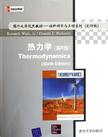热力学
出版时间:2006-12 出版社:清华大学出版社 作者:(美)沃克 页数:1164
Tag标签:无
内容概要
本书是为满足国内工科院校材料专业学生了解和掌握热力学原理和应用而引进出版的。 热力学是理工科,比如物理、化学、工程等学科的重要基础课程之一。在美国大学工学院的基础课程里,热力学是机械、化工、航空、环境、材料等工程专业的必修课。 Thermodynamics是为美国工学院本科生二年级的学生设置的普通热力学课程,内容主要分三个部分: 第一部分为热力学的基础部分,阐述了热力学第一、第二定律、熵的统计学解释、热力学参数。第二部分主要讨论了最基本的热力学关系,如能量平衡、热机和卡诺循环、不可逆过程、混合气体行为、扩展的热力学关系等。该部分还讨论了相与相平衡、气体与液体的行为以及相图的概念。第三部分介绍更接近实际的化学反应、化学平衡、气体循环,以及与此相关的实际应用。这个部分结合工程科学的实际,强调热力学与工业应用的关系,并以热力学的理论为基础讨论工程热力学概念和行为,比如燃料电池、制冷、热机等。 本书条理有序、结构清晰、内容丰富,十分适于一般工学院的热力学导论课程。同时,它也适用于相关专业的同类课程的参考。尤其本书所给出的思考作业题,内容十分广泛,而且突出重点,切题实用。 本书出版时,针对国内教学特点对本书15,16两章做了删节。
作者简介
.
书籍目录
PREFACE 1 BASIC CONCEPTS AND DEFINITIONS 1-1 The Nature of Thermodynamics 1-2 Dimensions and Units 1-3 System, Property, and State 1-4 Density, Specific Volume, and Specific Gravity 1-5 Pressure 1-6 The Zeroth Law and Temperature 1-7 Problem-Solving Techniques 1-8 Summary Problems 2 THE FIRST LAW OF THERMODYNAMICS 2-1 Concepts of Work and Energy 2-2 The First Law of Thermodynamics 2-3 A Conservation of Energy Principle for Closed Systems 2-4 The Nature of the Energy E 2-5 Heat Transfer 2-6 Expansion and Compression Work 2-7 Elastic Spring Work 2-8 Other Quasiequilibrium Work Interactions 2-9 Summary Problems 3 PROPERTIES OF A PURE, SIMPLE COMPRESSIBLE SUBSTANCE 3-1 The State Postulate and Simple Systems 3-2 The PvT Surface 3-3 The Pressure-Temperature Diagram 3-4 The Pressure-Specific Volume Diagram 3-5 The Temperature-Specific Volume Diagram 3-6 Tables of Properties of Pure Substances 3-7 Tabular Data and Closed-System Energy Analysis 3-8 The Specific Heats 3-9 Summary 3-10 Appendix: Fundamentals of Partial Derivatives Problems 4 THE IDEAL GAS, CORRESPONDING STATES, AND INCOMPRESSIBLE MODELS 4-1 Ideal-Gas Equation of State 4-2 Internal Energy, Enthalpy, and Specific-Heat Relations forIdeal Gases 4-3 Specific Heats of Ideal Gases 4-4 Energy Analysis of Closed Ideal-Gas Systems 4-5 The Compressibility Factor and the Corresponding States Principle 4-6 Property Relations for Incompressible Substances 4-7 Summary Problems 6 CONTROL-VOLUME ENERGY ANALYSIS 5-1 Introduction 5-2 Conservation of Mass Principle for a Control Volume 5-3 Conservation of Energy Principle for a Control Volume 5-4 Steady-State Control-Volume Energy Equations 5-5 Comments on Problem-Solving Techniques 5-6 Engineering Applications Involving Steady-State Control Volumes 5-7 Introduction to Thermodynamic Cycles 5-8 Transient (Unsteady) Flow Analysis 5-9 Summary Problems 6 THE SECOND LAW AND ENTROPY 6-1 Introduction 6-2 Heat Engines, Refrigerators, and Heat Pumps 6-3 Second-Law Statements 6-4 Reversible and Irreversible Processes 6-5 The Second Law and Entropy--Classical Presentation 6-5-1 Analytical Forms of the Kelvin-Planck Statement 6-5-2 General Second-Law Limitations for Heat Engines 6-5-3 The Thermodynamic Temperature Scale 6-5-4 Performance Standards for Reversible Heat Engines 6-5-5 The Clausius Inequality 6-5-6 The Entropy Function 6-5-7 Entropy Generation and the Closed-System Entropy Balance 6-6 The Second Law and Entropy--Alternate Presentation 6-6-1 The Second-Law Postulate 6-6-2 An Entropy Balance for a Closed System 6-6-3 The Thermodynamic Temperature Scale and the Carnot Efficiency 7 EVALUATION OF ENTROPY CHANGE AND THE CONTROL-VOLUME ENTROPY BALANCE 8 SOME CONSEPUENCES OF THE SECOND LAW 9 AVAILABILITY(EXERGY)AND IRREVERSIBILITY 10 NONREACTIVE IDEAL-GAS MIXTURES 11 PVT BEHAVIOR OF REAL GASES AND REAL-GAS 12 GENERALIZED THERMODYNAMIC RELATIONSHIPS 13 CHEMICAL REACTIONS 14 CHEMICAL EPUILIBRIUM 15 REFRIGERATION SYSTEMSA-1 SUPPLEMENTARY TABLES AND FIGURES(SI UNITS)A-2 SUPPLEMENTARY TABLES AND FIGURES(USCS UNITS)A-3 INTRODUCTION TO EES
图书封面
图书标签Tags
无
评论、评分、阅读与下载
用户评论 (总计6条)
- 原本英文的书太贵,自己印的话看着又不舒服,这个挺不错的,老师说了是学热力学的好资料
- 很好的书
值得推荐 - 价格适中,质量不错
- 学习英语与热力学一举两得
- 推荐看Atkins的热力学,简单易学,这个书我实在不知道定位是啥,对本科生吧,难了,对研究生吧,废话太多,以至于没有重点
而且卖的还比较贵 - 我还没读,如何评价?
